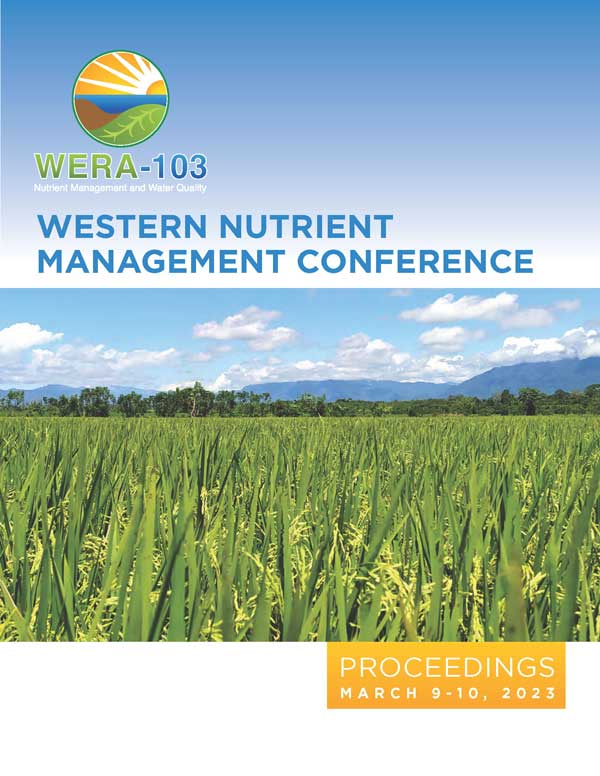Download the Conference Proceedings
Proceedings
Topics
| Filter results9 paper(s) found. |
|---|
1. Soil Health Changes Following Transition from an Annual Cropping to Perennial Management-Intensive Grazing AgroecosystemManagement-intensive Grazing (MiG) on irrigated, perennial pastures has steadily increased in the western US due to pressure for reducing public lands grazing, overall declining land available for pasture, and decreasing commodity prices. However, there are still many unknowns regarding MiG and its environmental impact, especially with regards to soil health. Over a two-year period, we studied changes in soil health under a full-scale, 82 ha pivot-irrigated perennial pasture system grazed wit... J. Ippolito, C. Shawver, J. Brummer, J. Ahola, R. Rhoades |
2. Developing a Soil Health Assessment Framework for Specialty Crop Systems and Soils of Washington StateTo ensure productive soils, agricultural sustainability, and food security, it is vital to maintain and improve soil health. However, over the decades, intensive agricultural practices have led to a decline in soil health. While most of these intensive agricultural practices negatively affect soil health, research has shown that it is possible to resuscitate soils with practices such as over cropping, and crop rotation. Much of the research on soil health in the US has been done in agronomic ... K.A. Sarpong, M. Mcilquham, L. Michel, D. Griffin |
3. Cover Crop Suitability for High Altitude Specialty Crop Organic Food ProductionThere is a growing interest in certified organic, specialty crop food production. With a larger population demanding organic products and organic products offering a higher premium for the producer, farmers are exploring the transition to organic farming. Organic producers in southeatstern Wyoming face multiple challenges in environments with high elevation, low precipitation, and have a short growing season. These challenges include management of persistent weeds, maintaining biodiversity, a... E. Moore, U. Norton |
4. Dairy Manure and Fertilizer Effects on Microbial Activity of an Idaho SoilDairy manure applications that have occurred in the past can have long-term lingering effects on crop production. Understanding the cause is important for current and future management practices. This study was conducted to assess selected microbial activity among past manure application rates. In a past study (2014-2016) in Kimberly Idaho, historic manure applications have been shown to have significant positive and negative effects on sugar beet production. The manure treatment histor... D.D. Tarkalson, R. Dungan, D. Bjorneberg |
5. Soil Health and Ecological Resilience on the PalouseHealthy soil is critical for global food security and other essential ecosystem services but is threatened by processes of soil degradation, with at least 33% of global croplands estimated to be moderately or highly degraded. Current soil health assessments provide insight into soil functional performance but often lack diagnostic criteria that assess management effects on soil function over time. We integrate soil health assessments with ecological resilience theory to better understand mana... A.G. Davis, D.R. Huggins, J.P. Reganold |
6. Vineyard Soil Health: What Soil Properties are Most Important?Washington is the second leading producer of wine grapes (Vitis vinifera) in the US, with over 60,000 acres in vineyards. With such a substantial acreage, it is crucial to know how management practices may affect soil and vine health in wine grape systems. Soil health indicators and threshold values have been extensively studied in commodity crops in the Midwest and the northeastern US, but there is much less information available for specialty crops in the Pacific Northwest. &... M. Mcilquham, D. Griffin-lahue, K. Sarpong, L. Michel |
7. Is Residue Management an Important Factor in the Soil Health of Perennial Grass Seed Production Systems?Residue management in agricultural systems is a crucial pathway of nutrient and organic matter flow and is predicted to affect soil health indices. In Western Oregon, perennial grasses for seed are a major crop, occupying roughly 150,000 ha in the Willamette Valley. Current estimates are that 80-85% of producers remove straw residue, exporting more than 650,000 US tons of straw annually. The primary objectives of this study were: i) evaluate soil health outcomes under residue retention and re... B. Verhoeven, A. Moore, D. Sullivan, M. Gonzalez-mateu |
8. Effects of Semiarid Wheat Agriculture on Soil Microbial Properties: A ReviewAgricultural management decisions on factors such as tillage, fertilization, and cropping system determine the fate of much of the world’s soils, and ... J. Norton, H. Rodgers, L. Van diepen |
9. Impact of Soil Health Practices in an Irrigated AgroecosystemRegional farming practices in cold semiarid irrigated agroecosystems with short growing seasons are shifting to reduced tillage and overhead irrigation to stay economically viable, but more research is needed on the impact of soil health practices such as crop diversification, reduced tillage, and livestock integration on soil physical and chemical properties in these systems. A multi-year study from 2014-2020 in the Bighorn Basin of Northwest Wyoming used a three-crop rotation (diversificati... T. Vance, V. Crowe, J. Norton |
